On Saturday (that is, April 17th, 2021), I deployed my fairly-long-in-development rewrite of the Nullbrook Found Media Archive website. Features I'm proud to share in this iteration include the ability to filter by decade or lot as well as search by string. Probably most worryingly for my webserver, the website also supports looking up a random item in the archive. All of these magical features come as a benefit of using an actual web framework and a backing database. It's a new era of legitimacy for my web development skills. Worth noting, there still isn't a lick of javascript on the site.
I wanted to start completely from scratch-- trying to match the minimal design of my personal blog while optimizing for caching from my CDN. As of the time of this writing, the site doesn't yet have video support, floppy disks, or even the pogs (which can still be found on the Internet Archive). Primarily, this was a choice of expediency. I was delighted with the experience of the new website over the hacked-together predecessor. Secondly, an imminent move to a large space gives me an opportunity to rearchive my film and floppy disk collections in a more professional manner as well as reunite with the chunk of collection that remains in the cold storage of a bedroom at my parents' home.
I pour one out for all the links I broke, but the Wayback Machine has a little taste of how it used to look. I consider this to be Nullbrook 1.0 and I plan to treat it with respect moving forward.
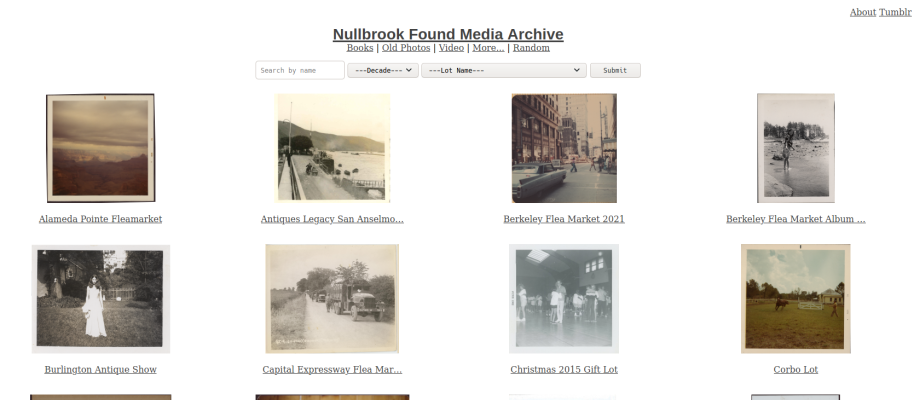
The new index page for https://nullbrook.org, now with a search bar
The Nullbrook Found Media Archive project didn't start as a website. There was no bold vision to make anything and everything I found mildly interesting in meatspace available online. I think I just came across some photos or pamphlets where I thought "this might be the only copy of this in the world." Finding myself as a bored kid in the suburbs with access to a merely passable HP scanner, I began to digitize, crudely digitize. I think I still have some horrible, off-center TIFFs of a fallout shelter manual that I had tried to hold onto the scanner bed with my hands.
Much of what I learned from the start came from helping my mother scan our own family's photos, but I soon found myself branching out into strangers' collections. I discovered old family photos at the same flea markets and garage sales I had been frequenting with my parents-- or later with friends once I got a driver's license. Photographs are substantially easier to digitize, thus I still have some of these scans from 2011 or 2012 when I was just getting started.
At first I thought the hobby a little strange, maybe a bit voyeuristic, sort of like going to the Photobucket Recent Uploads page (for those of you too young to recall, Photobucket had a page that displayed ALL recently uploaded photos and clearly many of the uploaders didn't realize that). Looking back at those high school years I realize I did a lot stranger things. Perhaps years of receiving positive feedback on the collection has made the oddness fade.
The process of collecting photos can be a fairly detached experience. It can be like looking through vintage postcards, choosing a selection based on aesthetics, subject or typography. However, I found that the approach I liked to take, buying in bulk, not only saved me money in this relatively cheap hobby, but also provided a level of context into the life of the subjects. Early on in my collecting, I met individuals: Ruth Rhende, Merguet and Velma, Gerald, to name a few, that showed up in enough photos to have a cohesive story. Even with scant handwritten notes, it's possible to follow the arc of a person's life in these photos. Then, moreso than now, the photographer tended to be a parent, the subject a child. Thus, in many boxes of photos I came across, one can follow someone (who is likely deceased now) grow from a baby in the arms of a relative, to a toddler on a bike, a schoolkid goofing off, a teenager with their romantic interest, a married couple. At this point, it's hard to be dispassionate. It's hard not to hold this memento mori and reflect on your own life.
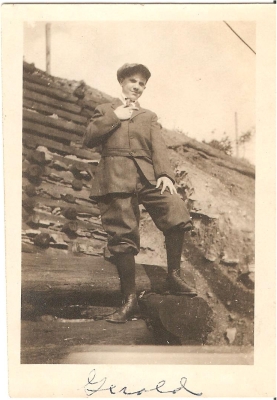
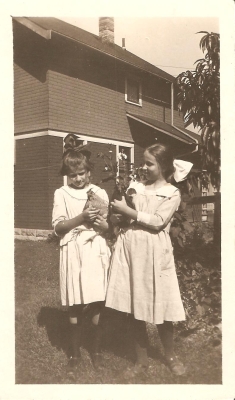
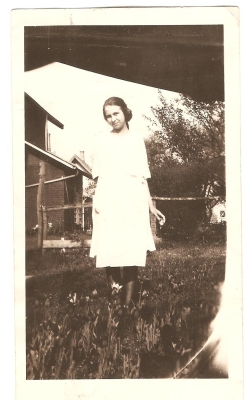
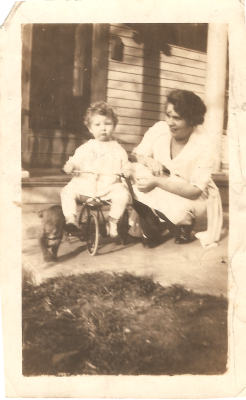
From left to right: Gerald, a young Velma and Merguet, Merguet, Ruth Rhende
Not gonna lie, had a bit of a crush on Merguet
Over time, I found I typically gravitate toward more candid photos. Baby photos and studio photos are bland. Everyone thinks their baby is the greatest thing, but much like studio photos, the shots come off looking unnatural or simply repetitive of the thousands of other similar photos. What I end up purchasing (and by extension what ends up in the archive) comes mostly from my opinionated taste and somewhat from what I feel others would find interesting. I love a good unique or well framed landscape, doubly so if it's a polaroid. Nonetheless, I'm often reminded by friends or the internet that having a human or cute animal subject provides an opportunity to bond with the past on a more huamn level.
I've found photograph vendors have a varying level of attachment to their merchandise. Especially when I was younger, I found it hard to convince the generally elderly and skeptical vendor that I was seriously interested in buying the whole box. I will generally outright refuse to pick anything up if it's $1-per-piece or even worse, individually priced. I have the best luck on my charisma/bartering roll when the seller has clearly been lugging the same box of paper around for years in hopes of selling it. If at all possible, I do try acquiring full collections or at least as much of a collection a given booth or antique store still has available. I do feel regret when I've made a photo part from its original assemblage, but many times the complete lack of annotation along with countless reshuffling between estate sales and antique vendors prevents any given item from having any definite relation to the other articles in the stack. Yet, even photos from different families can share some context in what part of the world they live in.
Around the time I went to college I became curious about film and picked up my first 8mm projector. The quality of the recordings I made of these (literally pointing a digital camera at a projection) was abysmal, but I have fond memories of watching some of these found reels for the first time--sometimes alone, sometimes with my roommates. Moving images, even choppy, corroded, or overexposed make this stranger deeply familiar. I've tried, poorly, to express this in my Bellant Owl music videos, of which I've dedicated this one to Paradise, California-- the setting of this film which suffered a devastating loss during a wildfire in 2018. It's obvious how poorly I'm digitizing this footage. While my skills at photo archiving improved over the years with the purchase of a nice flatbed scanner, the development of an automatic cropping tool, and a number of other automation tools, my ability to wrangle a projector's output into a digital camera's input has not improved.
It's my hope that with my move to a larger space, I'll be able to justify buying or building a full telecine or even film-scanning setup. In the meantime, I've removed the video section in the rewrite with the hopes to add it once again when I have archival quality files as well as access to the entirety of my collection.
I've long been fascinated with text media and indeed I've picked up the rather expensive hobby of collecting old books. In general, old books don't typically meet my threshold of needing-to-be-archived since they are often already archived by various libraries around the web and are quite challenging to scan with conventional tools. Thus, many of the books/zines that have been added to the Nullbrook archive are limited-run, softcover, and lay-flat so as to fit on a scanner bed. Even if the book fits on the scanner bed, my skills at scanning/transforming into a PDF are well within the novice category. So, while this most recent rewrite includes PDFs alongside the ability to view images of the books in-browser, I have plans to rearchive all of these items more professionally.
At the very least, future iterations will utilize qpdf and some amount of automation tooling to scan pages, split the pages of a spread book, apply optical character recognition, and reasonable lossy compression. Indeed, if I do decide to put sufficient effort into the project, I'll be assembling a book scanner. This would allow me to begin scanning the many old tomes I've found myself collecting.
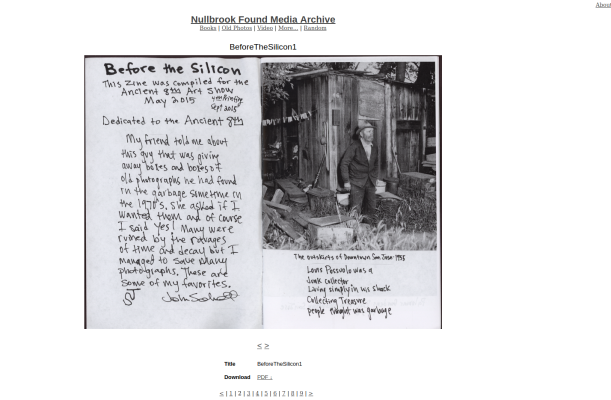
You can click through the books in the browser on the new site which is kind of cool
In the past year or so, I've been blessed by a friendship with an individual deeply familiar and technically adept at digital media archiving. They've even run Twitch streams of archiving floppy disks using a highly accurate toolset. I've always known that my floppy disk archiving tools were best-effort and hardly up to ArchiveTeam standards, but being around Terin has been instructive on just how poor quality my rips are!
So, once again, floppy disks are not in the new site while I take a more thoughtful redisign of how I archive these items.
Acquiring a bunch of junk is easy and fun, annotating and researching each item is less so. One of the most valuable aspects of an archive is the ability to search, filter, and find related items. As it stands, the only real metadata I have about the photos in my collection are the handwritten notes or date stamps. After scanning a photo, I type up this metadata in the filename. This process is far from thorough or machine-readable. It's only been in the past few years that I've become disciplined in how I name files so that they can be parsed consistently by the script I use to insert into the Nullbrook database.
While I once dreamed of entering into archival studies, I found my skills better applied elsewhere. So I don't have the time or patience to deeply annotate every item. My mother, now retired and allegedly bored, had offered to help but I feel like she's too daunted by getting the annotations "right." But really, I don't need perfect correctness, I just need some help in briefly describing/tagging photos. I've toyed with the idea of using some sort of machine learning model to add these annotations, but I need a decently-annotated corpus of data to work off of!
So I'm asking you, do you have any interest in helping me annotate the items in this archive? If you're serious, I can pay you whatever you think is fair compensation. I can pay in items for the archive or in like, you know, real money. Please reach out to [email protected] if this sounds like something you would enjoy.
Before Nullbrook was Nullbrook, it was a Tumblr blog: boxesofoldphotos.tumblr.com. Early on I was manually posting photos to the queue but have since put the blog on autopilot with an automated photo posting system. While the site has seen better days, that blog remains the primary way that folks interact with the archive. With four thousand posts and ten thousand followers (probably many bots/deactivated accounts if I'm being honest), it continues to be the dopamine feed tube that keeps me diligently improving the archive experience.
My desire to build Nullbrook as a standalone website came from a desire to remove many of the restrictions that come with social media platforms-- being able to offer video, downloads, search functions, and other features on my own terms. That being said, social media platforms provide a way for the general public to enjoy bits of the archive every day with minimal friction.
I was asked the other day by an Internet stranger if I had an Instagram account for the archive. While honored that someone found the archive enjoyable, I simply cannot bring myself to give additional staying power to Facebook, an uncontrollable behemoth that has been trying to smother the web. Instead, I would like to share @[email protected], a micro-blog on the Fediverse.
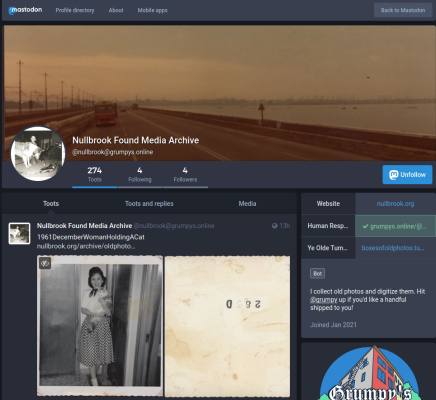
So popular, man
This is the second time I've tried making a move onto the fediverse. My initial foray a couple years back failed as my bot was criticized for "doing things wrong" by the instance admin. This left a bad taste in my mouth and I found I didn't care much about the platform. However, in 2020 I realized I would need some form of human interaction during quarantine. This time around, I made the decision to run my own instance, grumpys.online and make my own rules. Inspired by @[email protected], I post an item from the archive automatically once or twice a day.
With this account, I'm not trying to be some hyper-popular account, but voice my support for the Fediverse. Neither the main Nullbrook website or the Tumblr blog are going away, but I hope the Mastodon account is useful to anyone who is done with centralized social networks.
Well I guess I should finish this post now and finish packing. Both wol.fm and nullbrook.org will be down while I move to my new place. See you on the other side.